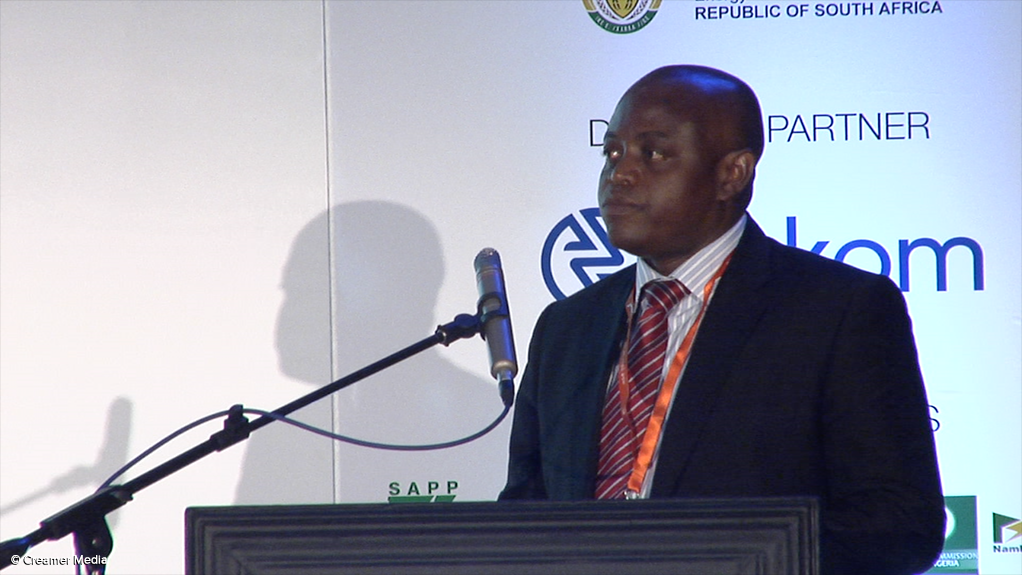State-owned Zambia Electricity Supply Corporation (Zesco) aimed to export its 200 MW to 300 MW surplus energy after an ambitious $5-billion generation and transmission expansion brought its capacity to over 2 200 MW.
Zesco transmission development director Christopher Mubemba said the “land-linked” country’s geographical position provided an opportunity to link its national grid to its eight neighbouring countries over the next three to five years.
Speaking to Engineering News Online on the sidelines of the Power and Electricity World Africa 2014 conference, held in Sandton on Tuesday, he said work was under way to upgrade and build new power transmission lines to provide electricity in an effort to reclaim its 1980s status as a net exporter.
The nation’s current capacity of 1 820 MW was met with demand of more than 1 650 MW – projected to grow 6% a year – with a 250 MW power deficit during peak times.
A presentation by Zesco MD Cyoriam Chitundu showed that net exports to Namibia, the Democratic Republic of Congo (DRC) and Botswana were roughly 5% of total generation.
However, with Zambia’s electricity generation and transmission expansions and new projects, the nation would be able to supply electricity to its other power-strained neighbours.
The current 66 kV and 200 kV transmission lines linking Zambia to Botswana and Namibia, respectively, would be upgraded to 330 kV, while Zimbabwe and DRC currently had 320 kV and 220 kV lines respectively.
Tanzania would get a 330 kV line within the next three years, with Zesco in talks with Mozambique and Malawi to extend transmission lines to the respective countries in the short term.
The group was also in discussions with Angola regarding medium-term plans to construct a transmission line linking the two countries within the next five years.
Several other multimillion-dollar intercountry transmission projects were also currently under way to connect several stations in Zambia’s different provinces to the national grid and enhance the capacity of existing lines.
Zesco had, over the last year, yielded 210 MW extra capacity with the $320-million rehabilitation and updating of its three major hydropower stations, including the Kafue Gorge and Victoria Falls power stations.
The group was currently finishing off the expansion of its third hydropower station, Kariba North, which added two 180 MW generators to the current four 180 MW units. The first unit was commissioned in December, with the second currently being tested.
Further, new generation projects included the $420-million, 360 MW Kariba North bank extension and the 50% completed $232-million Itezhi Tezhi hydropower project, which would add 120 MW to the grid in early 2015.
The $2-billion Kafue Gorge lower hydropower project would add another 750 MW to the grid by 2018, bringing total capacity to over 3 000 MW.
With about 40% of Southern Africa’s water resources located in Zambia, Zesco said the country had the potential to generate 6 000 MW of energy from hydropower, allowing small hydropower projects to get under way.
These included the $25-million, 1.4 MW Mujila Falls; the $164-million, 86 MW Lusiwasi Lower; the $52-million, 15 MW Lunzua; and the $47-million, 15 MW Lusiwasi Upper.
Zesco said the 6 MW to 14.8 MW Chishimba Falls and the 5 MW to 10 MW Musonda Falls had also been rehabilitated and updated.
While hydropower generated 99% of Zambia’s electricity, this was expected to shift to 75% as the country explored thermal power generation.
The development of two 300 MW thermal-generation power projects were currently under way.
NAMIBIA’S EXPORT AMBITIONS
At the conference, Namibia reiterated its plans to shift the bulk of its domestic electricity supply to cross-border suppliers as it expanded its own power generation capacity.
State-owned power utility NamPower’s portfolio currently included four power stations, which included one coal-fired power plant, with a collective capacity of about 500 MW. Plans to add nearly 2 000 MW to the grid were under way.
The country was injecting R30-billion over the next five to six years – to be absorbed mostly by national priority project, the Kudu combined cycle gas turbine – to boost capacity, NamPower CEO Paulinus Shilamba said on Tuesday.
By June, the group would be in a position to conclude all commercial agreements, with the Oranjemund-based power station expected to come on line in 2018.
NamPower was in discussions with South Africa’s State-owned power utility Eskom and Zesco for potential offtake agreements to take up half its generation capacity.
Among Namibia’s other power projects were a 600 MW hydropower initiative, two potential wind farm projects generating 114 MW, three small solar photovoltaic units, one diesel-powered station and an 800 MW gas-to-power plant project.
Namibia needed to urgently increase capacity after the distribution of the current energy supply to Namibia raised a red flag.
The nation, which has a population of 2.1-million, currently generates only 39% of its own electricity, with 40% of its power coming from Eskom, while Zesco and the Zimbabwe Electricity Supply Authority contribute 9% and 12%, respectively, to the grid.
NamPower had instituted several initiatives to ensure short-term electricity supply amid increasing power shortages.
The programme included the implementation of demand-side management initiatives, which would see the roll-out of 20 000 solar water heaters and one-million energy efficient light bulbs.
The programme extended to the rehabilitation of all power stations, including the R300-million rehabilitation of the Van Eck power station, as well as the installation of emergency power generators and the negotiation of new and the extension of existing power purchase agreements, besides others.
EMAIL THIS ARTICLE SAVE THIS ARTICLE
To subscribe email subscriptions@creamermedia.co.za or click here
To advertise email advertising@creamermedia.co.za or click here












